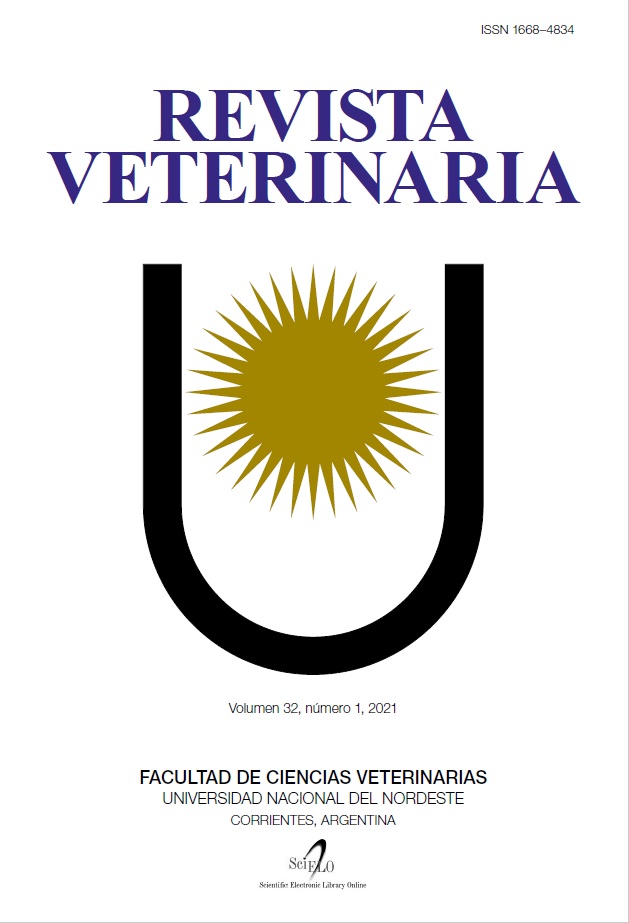Efecto del resveratrol en el porcentaje y calidad de embriones in vitro generados por separación de blastómeras en bovinos
DOI:
https://doi.org/10.30972/vet.3215644Palabras clave:
clivaje, desarrollo embrionario, células totales, células vivasResumen
El estado oxidativo es un factor importante que determina el desarrollo de embriones bovinos. El objetivo de este estudio fue evaluar el efecto del resveratrol en el porcentaje y calidad de embriones in vitro generados por separación de blastómeras en ganado bovino. Ovocitos provenientes de matadero fueron madurados y fecundados in vitro por el método convencional. Terminada las 18 horas de fecundación, los cigotos se cultivaron por 3 días en medio fluido oviductual sintético (SOF) para el control y suplementado con 2 µM y 0,5 µM para los tratamientos. Al día 3 se despojaron de su zona pelúcida (ZP) para ser cultivados a razón de cuatro blastómeras en well of thewell (WOW) por 6 días en medio SOF suplementado con resveratrol. Se evaluaron datos porcentuales de clivaje y división embrionaria (8 a 10 blastómeros) a los 3 días de cultivo superando la suplementación con 0.5µM de resveratrol (p<0,05). A los 6 días post separación de blastómeras se evaluó porcentaje de embriones, cantidad de células totales, células vivas y células muertas, utilizando la tinción Hoechst, FDA y PI respectivamente. No hubo diferencias en el porcentaje de blastocistos entre tratamientos; sin embargo, la suplementación con 0,5 µM de resveratrol al medio SOF tuvo mayor cantidad de células totales y células vivas (p<0,05). Finalmente la suplementación con resveratrol al medio SOF no aumenta el porcentaje de blastocistos pero sí mejora su calidad usando una concentración de 0,5 µM.Descargas
Citas
Galeati G, Spinaci M. 2015. Resveratrol from red grapes: an useful agent for oocyte maturation and subsequent embryonic development. Austin Journ Fertil 2: 1-3.
Gaviria S et al. 2018. Resveratrol supplementation promotes recovery of lower oxidative metabolism after vitrification and warming of in vitro produced bovine embryos. Reprod Fertil & Develop 31: 521-528.
Gambini J et al. 2013. Resveratrol: distribución, propiedades y perspectivas. Rev Españ Geriat & Gerontol 48: 79-88.
Giaretta E, Spinaci M, Bucci D, Tamanini C, Galeati G. 2013. Effects of resveratrol on vitrified porcine oocytes. Oxid. Med. Cell. Longev. ID 920257. DOI:10.1155/2013/920257.
Huang L, Shiao N, Hsuuw Y, Chan W. 2007. Protective effects of resveratrol on ethanol-induced apoptosis in embryonic stem cells and disruption of embryonic development in mouse blastocysts. Toxicology 242: 109-122.
Jhonson W, Loskutoff N, Plante Y, Betteridge K. 1995. Production of four identical calves by the separation of blastomeres from an in vitro derived four cell embryo. Vet Record 137: 15-16.
Johnson M, Nasr E.M. 1994. Radical solutions and cultural problems: could free oxygen radicals be responsible for the impaired development of preimplantation mammalian embryos in vitro. BioEssays 16: 31-38.
Kitagawa Y, Suzuki K, Yoneda A, Watanabe T. 2004. Effects of oxygen concentration and antioxidants on the in vitro development a lability, production of reactive oxygen species (ROS), and DNA fragmentation in porcine embryos. Theriogenology 62: 1186-1197.
Kwak S, Cheong S, Jeon Y, Lee E, Choi K. 2012. The effects of resveratrol on porcine oocyte in vitro maturation and subsequent embryonic development after parthenogenetic activation and in vitro fertilization. Theriogenology 78: 86-101.
Lee K, Wang C, Chaille JM, Machaty Z. 2010. Effect of resveratrol on the development of porcine embryos produced in vitro. J Reprod Dev 56: 330-335.
Liebfried L, First, N. 1979. Characterization of bovine folicular oocytes and their ability to mature in vitro. J Anim Sci 48: 76-86.
Liu Y et al. 2013. Resveratrol protects mouse oocytes from methyl glyoxal induced oxidative damage. PLoS One 8-10.
Nasresfahani M, Aitken J, Johnson M. 1990. Hydrogen peroxide levels in mouse oocytes and early cleavage stage embryos developed in vitro or in vivo. Development 109: 501-507.
Parrish J, Krogenaes A, Susko PJ. 1995. Effect of bovine sperm separation by swim up orpercoll on success of in vitro fertilization and embryo development. Theriogenology 44: 859-870.
Pirola L, Fröjdö S. 2008. Resveratrol: one molecule, many targets. IUBMB Life, 60: 323-332.
Salzano A et al. 2014. Effect of resveratrol supplementation during culture on the quality and cryotolerance of bovine in vitro produced embryos. Anim Reprod Science 151: 3-4.
Sato E, Matsuo M, Miyamoto H. 1990. Meiotic maturation of bovine oocytes in vitro: Improvement of meiotic competence by dibutyryl cyclic adenosine 3’5’monophosphate. J Anim Sci 68: 1182-1187.
SPSS Inc. 2007. SPSS for Windows, version 16.0. SPSS Inc., Chicago.
Takeo S et al. 2014. Resveratrol improves the mitocondrial function and fertilization outcome of bovine oocytes. Journal Reprod & Develop 60: 92-99.
Vajta G et al. 2000. New method for culture of zona-included or zona free embryos: the well-of-the well (WOW) system. Mol Reprod Dev 55: 256-264.
Zullo G. 2015. Natural antioxidants during in vitro culture improve embryo quality in cattle. Repositorio.untrm.edu.pe›bitstream›handle›UNTRM. Tesis Doctoral, p.1-162.
Descargas
Publicado
Cómo citar
Número
Sección
Licencia
Política de acceso abierto
Esta revista proporciona un acceso abierto inmediato a su contenido, basado en el principio de que ofrecer al público un acceso libre a las investigaciones ayuda a un mayor intercambio global de conocimiento. La publicación por parte de terceros será autorizada por Revista Veterinaria toda vez que se la reconozca debidamente y en forma explícita como lugar de publicación del original.
Esta obra está bajo una licencia de Creative Commons Reconocimiento-NoComercial 4.0 Internacional (CC BY-NC 4.0)










.jpg)
.jpg)



